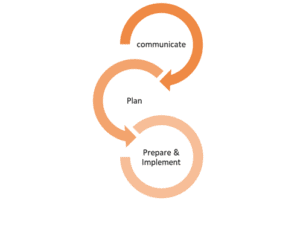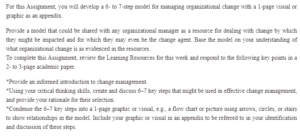Change Management and Change Agents-The Dynamic Duo
Change management is a framework that facilitates an organization’s change process. Change management processes have evolved, over time, into maturity. Planning, preparation, and support provision are critical to successfully managing change in an organization. Change management is complementary to the constant need for organizations to adopt new ideas, concepts, and practices. These adoptions promote and enhance the process of working efficiently and effectively. The dynamism within the markets of business operations demands the flexibility of organizations. Organizations can compete with their other players more efficiently through successful change management. An organization that refuses to adopt change will fail because it cannot gain new work ethics, practices, knowledge, skills, or operational standards that enhance its competitiveness (Prosci Inc., 2022). Thus, change is an important aspect and mandatory in every entity.
Are you in urgent need of assignment help ? Get in touch with us.
Elements of Change Management
The change management process requires a detailed model that dictates action because of possible resistance and the need to ensure success. Communication is a critical aspect of change management. Communication tops the list of activities that should enable employees to get by beforehand and during the change process. Through advanced communication, the management can reduce the likelihood of employee resistance. The administration must inform employees about three main aspects: the expected change, the need for change, and the process of implementing change (Importance of Communication During Change: A Case of the Municipality of Vlora, 2017).
Accordingly, the expected change should be communicated to employees in advance. This communication ensures that all employees are informed. It also allows them to provide their opinions regarding the proposed change. The proper methods must be applied at the right time for this communication to be effective. The employees are less likely to resist change if they understand the risks and benefits associated with the process. This understanding eliminates or reduces the fear of the unknown and encourages employees to participate actively in the change process. Besides communicating the actual change that employees should expect, sharing the change’s implementation process (Mariana & Nadina, 2015). Providing this information ensures that employees are not left out of the process. Subsequently, the change process occurs while they are aware. They begin to understand their roles in the process of change management.
Finally, it is essential to communicate the need for change in the communication process. Change occurs for a reason, which employees should be informed about. The reason for the change is communicated to open an opportunity for further employee input. Staff members understand the different work processes required for product development or service delivery (Mariana & Nadina, 2015). Such involvement places them in an ideal position to provide information about the elements that need change. To add on, they also understand the solutions that could work. Their input makes them feel valued and appreciated by the management. Therefore, ensuring that the employees are consulted during the change management process is necessary.
After communication, the human resource manager and other management team members should outline the change process and follow up on its implementation. The implementation process also includes preparing the employees through training, needs assessment, impact analysis, and provision of information (SHRM, 2022). Training employees is essential because it assures them of their continued relevance. It also significantly alleviates the fears that would be associated with such change.
Change Management Model
The proposed change model includes three main aspects. The first is communicating with the various stakeholders. The employees should be the first group, while the external stakeholders should be informed later.
- Communicate to internal stakeholders, specifically employees.
- Communicate to external stakeholders.
These two steps are essential to ensure that all stakeholders agree with the change or put up minimal resistance. Accordingly, specific changes will require communication with clients, while others do not need consulting. Therefore, the organization should determine this aspect. The management should also select the most appropriate communication methods and timing within these steps. Planning is the second step and involves multiple steps:
- Create an implementation plan.
- Set up clear goals, roles, and milestones.
The change implementation process is cumbersome if the planning element is not well thought out. Consequently, creating a plan that includes goals, milestones, and clear roles eases the implementation process.
Preparation and implementation are the final steps in the model. The two are combined because the implementation process depends on the preparation of the most critical stakeholders in the process.
- Conduct a needs analysis.
- Train employees on their new roles
- Implement the change
Conducting a needs analysis is essential because it highlights employees’ skills and knowledge gaps. Essentially, it enables the HR department to design the training program, set its objectives, and identify the most effective strategies to achieve these. The progress monitoring process is essential in ensuring adjustments are made.
Finally, the proposed model is an umbrella that covers the entire change management process. The management should gain awareness of the critical steps for successful implementation. The inclusion of the proposed actions increases the chances of successful change management.
Appendix 1: Proposed Model of Change

References
Importance of Communication During Change: A Case of the Municipality of Vlora. (2017). European Journal of Multidisciplinary Studies, 2(1), 15-19.
Mariana, P., & Nadina, R. R. (2015). Employee Involvement In A Change Process – A Case Study For Romanian Organizations. Annals of Faculty of Economics, 1(1), 1158-1164.
Prosci Inc. (2022). Change Management.
SHRM. (2022). Managing Organizational Change. Retrieved from https://www.shrm.org/resourcesandtools/tools-and-samples/toolkits/pages/managingorganizationalchange.aspx
ORDER A PLAGIARISM-FREE PAPER HERE
We’ll write everything from scratch
Question 
For this Assignment, you will develop a 6- to 7-step model for managing organizational change with a 1-page visual or graphic as an appendix.

Change Management and Change Agents-The Dynamic Duo
Provide a model that could be shared with any organizational manager as a resource for dealing with change by which they might be impacted and for which they may even be the change agent. Base the model on your understanding of organizational change, as evidenced in the resources.
To complete this Assignment, review the Learning Resources for this week and respond to the following key points in a 2- to 3-page academic paper.
*Provide an informed introduction to change management.
*Using your critical thinking skills, create and discuss 6–7 key steps that might be used in effective change management, and provide your rationale for their selection.
*Condense the 6–7 critical steps into a 1-page graphic or visual, e.g., a flow chart or picture using arrows, circles, or stairs to show relationships in the model. Include your graphic or visual in an appendix to be referred to in your identification and discussion of these steps.
